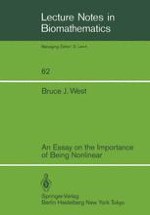1985 | OriginalPaper | Buchkapitel
What is it that was Really Said?
verfasst von : Bruce J. West
Erschienen in: An Essay on the Importance of Being Nonlinear
Verlag: Springer Berlin Heidelberg
Enthalten in: Professional Book Archive
Aktivieren Sie unsere intelligente Suche, um passende Fachinhalte oder Patente zu finden.
Wählen Sie Textabschnitte aus um mit Künstlicher Intelligenz passenden Patente zu finden. powered by
Markieren Sie Textabschnitte, um KI-gestützt weitere passende Inhalte zu finden. powered by
The series of lectures on which this essay is based was developed for an audience with a heterogeneous scientific background which varied from music theory to psychiatry to organic chemistry. The intent of the series was to draw parallels between different disciplines and to perhaps uncover an underlying unity. Instead of this, we in fact uncovered the self-imposed limitations that scientific investigators have established in their efforts to make sense out of complex systems and processes. Starting with the first of the modern scientists (Newton) I have attempted to show how the evolution of a linear world view has dominated scientific thinking in natural philosophy. The efforts of Newton to understand mechanistic relations and those of Gauss to interpret large data sets, along with their contemporaries, have contributed to this limited and limiting view of the world. It is not my intent to in any way minimize the monumental contributions of these two great men to our understanding of the physical world. But I do wish to emphasize the influence that this style of thought has had outside the physical sciences. For example, it was this perspective that prompted Descartes to say:
“If we really knew all the parts of the seed of any particular animal, man, for example, we could deduce from that alone, by certain and mathematical reasoning, the shape and conformation of each of his limbs.”
